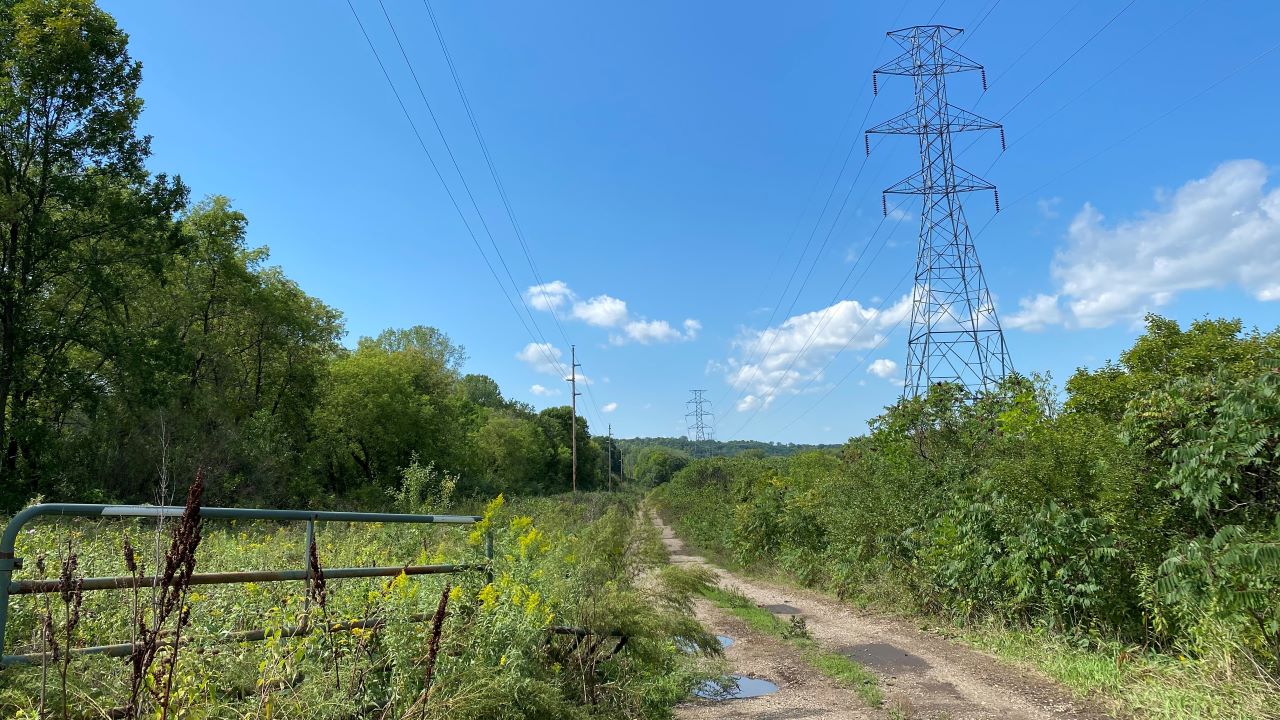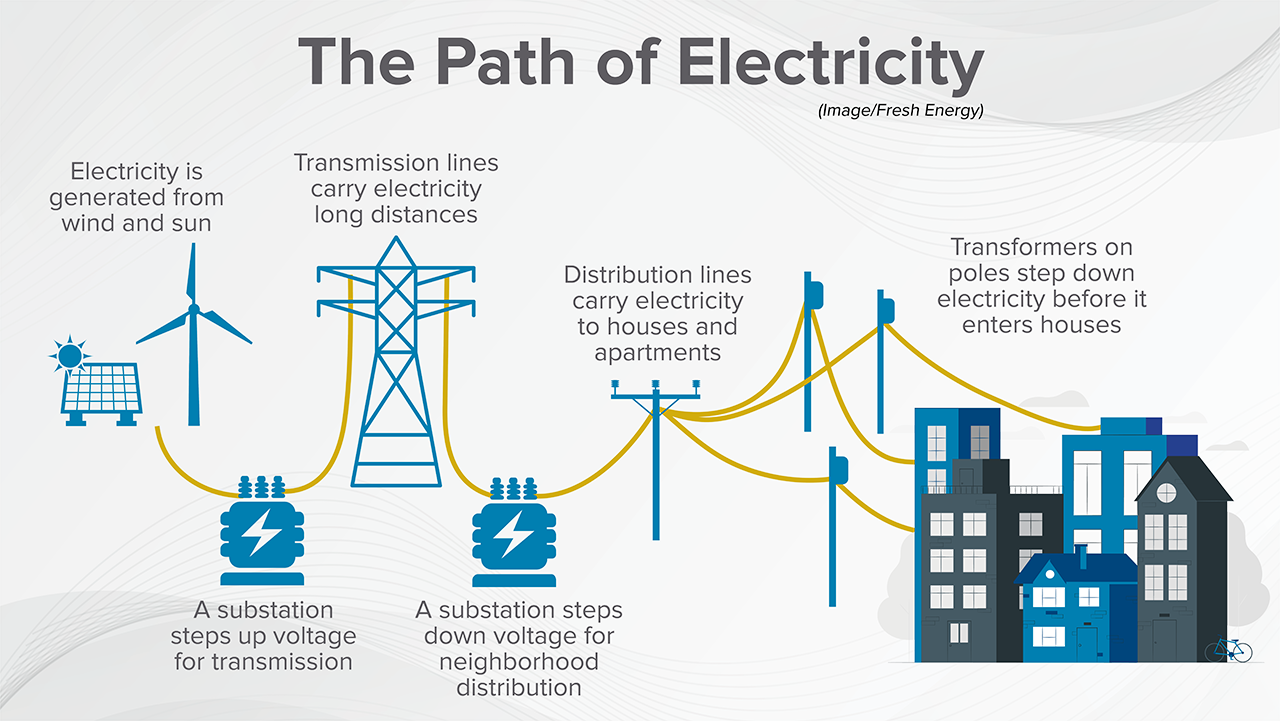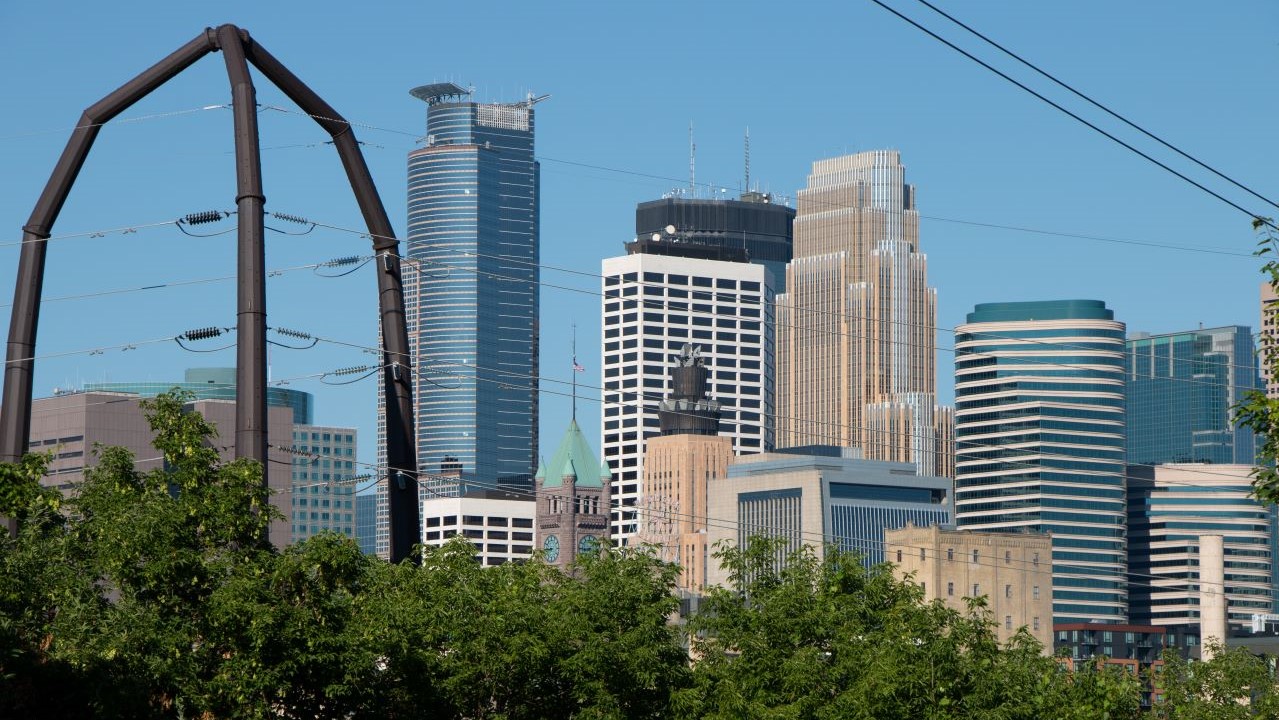
At Fresh Energy, we talk a lot about shifting our electricity generation away from fossil fuel and to carbon-free sources like wind and solar. The good news is that this change is happening! Each year, more and more renewables are coming online, and fossil fuel plants are running less often and even closing. But as we transition toward this clean energy future, there is a key piece of the puzzle that must be addressed: the grid.
While accelerating the adoption of carbon-free energy is critical, just as important is ensuring that the system we use to get this electricity from point A to point B is ready to handle the continuing increase in renewable generation. We need the right transmission for the job to ensure we can get this electricity to where people live and work. Unfortunately, our current transmission system was built for the fossil fuel age and is ill-equipped for the clean energy era we are moving toward.
If you follow along with Fresh Energy’s updates and are signed up for our new Action Network, you’ve probably heard us frequently use grid-related terms such as generation, transmission, distribution, and grid modernization. But what exactly is the grid? Who is in charge of it? What does it look like now and how does it need to change to support what’s next? Podcasts more your thing? Listen to our conversation about the grid here.
What does the grid do?
The electric grid is the vast network of transmission lines, substations, and more that ferries electricity from a power plant, wind farm, solar farm, etc. to consumers, whether that is to a home, hospital, school, local brewery, factory, or other business. In a way, the grid is a bit like its own ecosystem, sustained by a wide mix of energy companies, utilities, service providers, and government officials at federal, state, and local levels all working together to deliver reliable energy to consumers.
The basic components of the grid are:
- Generators – Generators include coal, natural gas, and nuclear power plants, as well as solar arrays and wind farms—all of which generate varying amounts of power based on size and capacity.
- Transmission lines – These are the big, high voltage lines that you see near highways. They move electricity long distances and deliver it at much greater intensities. Sometimes these lines are buried.
- Substations – Substations transform voltage from high to low, or vice versa, and generally sit between generators, transmission lines, and distribution lines.
- Distribution lines – Distribution lines are lower voltage lines that bring electricity from substations to your home and neighborhood. They are smaller lines that cover shorter distances and can be above ground or buried.

In a nutshell, our grid is split between the electric transmission system and the electric distribution system. The transmission system is designed for the long-distance transfer of electricity, sending large amounts of electricity, often crossing multiple states. The transmission system meets the distribution system at large transmission substations. From there, electricity travels across the grid via local distribution electricity lines to homes, businesses, and other consumers. Essentially, the grid is what is providing the electricity you need to flip on a light switch, toast a slice of bread, or plug in your electric vehicle for charging.
How does the grid work?
The grid balances electricity generation with electricity consumption, also called “load,” across a large geographic footprint. Your local electricity grid is interconnected with other local grids to form larger networks across the U.S. for both reliability and commercial purposes. At the highest level, the main North American grid is split into four regions, called “Interconnections”: Eastern, Western, Texas, and Quebec. These Interconnections are divided into grid operators, each independently managing their portion of the larger grid.
Of the 36 grid operators in the Eastern Interconnection, the largest by geographical area is the Midcontinent Independent System Operator, widely known as “MISO”—pronounced my-so. MISO manages Minnesota’s portion of the grid, and its individual footprint consists of 15 different states and the Canadian province of Manitoba, serving over 42 million people.
MISO’s primary job is to constantly balance electricity supply with electricity demand in order to maintain reliability for consumers across its territory. MISO also administers a variety of wholesale energy markets and plans future transmission build-out—but that’s a conversation for a future blog post!
Even though we are making great advances in electricity storage, the majority of electricity is currently not capable of being stored. So, one of the primary roles of the electric grid is to ensure that power generation is equal to power consumption, at all times. This means that if you turn on your coffeepot or start the electric kettle for a cup of tea, somewhere a power generator must simultaneously produce just enough extra electricity to power that coffeepot or kettle. And if everyone turns on their kettle at the same time, that adds up to a lot of power. That’s why certain events—like the Super Bowl and the World Cup, as well as hugely popular live TV shows that draw large viewing audiences—can often produce a surge in electricity demand that has a measurable impact on the grid.
Grid operators like MISO plan ahead for these events, just as they plan ahead for the fluctuation of energy supply and demand that occurs in every 24-hour cycle that follows daily temperatures and electricity use. Fail at this task, and grid operators will have no option but to shut down power for vast swaths of customers, something called “load shed.” This is precisely what ERCOT, the Texas grid operator, was forced to do during the 2021 winter event. And if a grid operator can’t control such an imbalance in time, the whole grid could come to a halt, resulting in outages lasting weeks or even months.
In the continental United States alone, the grid connects more than 9,200 electric generating units, representing more than 1 million megawatts of generating capacity. In all, the grid consists of more than 300,000 miles of transmission lines across all three U.S. Interconnections.
How is the grid evolving?
Our current grid was built out in an era when fossil fuel power plants were the standard source of electricity generation. Since then, how and where we generate our electricity has changed. For example, instead of burning coal for electricity near urban centers, we are building wind farms and solar arrays in locations that are optimal for capitalizing on those resources. Often these places are further away from urban centers, which means that transmission becomes even more important. But transmission buildout alone is just one part of a multifaceted plan for modernizing our grid.

Building new, modern, and climate-proof infrastructure for the grid that integrates within the current system can take more than a decade. This is in part because of the time it takes to plan and obtain local, state, and federal approval for long-distance transmission lines. It takes power companies, utilities, service providers, advocacy groups, and government officials at all levels working together to reimagine and update our electric grid so that it is primed to support more and more renewable energy—and we’re making progress.
Grid modernization—which will also lead to a “smart grid”—will help the U.S. prepare for a net-zero future while increasing the resiliency of our clean energy economy. Forward-thinking grid modernization will pave the way for more widespread access to clean energy, reduce power outages in homes across the country, and help lower energy bills for everyone by moving cheaper, cleaner electricity to where it is most needed. One of our greatest tasks is to bring everyone along on this journey—from those at the top who may fear changes, to under-resourced and historically marginalized communities who stand to benefit greatly from these updates.
What’s next for the grid?
As we build the grid of the future, we anticipate increasingly innovative solutions that include more renewable energy generation located on rooftops, more grid infrastructure along highways, in old railroad rights-of-way, and more flexible electric use in buildings, homes and transportation. Additionally, solutions like microgrids, battery storage, and other “distributed energy resources” will also become even more important. Fortunately, MISO and North America’s other grid operators are in a unique, non-partisan position to facilitate progress and oversee continued grid expansion as states, utilities, and others engage in ongoing long-term planning based on their own renewable energy goals.

But the clock is ticking. Between the ever-increasing threat of extreme weather events caused by climate change, consumer demand for more renewables, and the challenge of battling political ideologies and powerful status quo fossil industries, we have not made the progress we should toward the grid of the future. This is why the work of organizations like Fresh Energy is so important.
At Fresh Energy, our policy experts are working to ensure Minnesota and our region as a whole builds a future-proof electric grid that can handle extreme weather, increased demand to move away from fossil fuels, and a growing carbon-free electricity supply. To do this, we’re working in collaboration with regional partners at MISO and partaking in wide-ranging policy and grid modernization efforts that include long range transmission planning, and more.
Even though Fresh Energy’s grid work is extremely technical and can be painstakingly slow and challenging, it is often the most rewarding. We know that the grid we build today will serve us generations into our clean energy future.
Still have questions about transmission planning and our grid operator, MISO? Stay tuned for a follow-up blog where we’ll discuss everything you need to know about MISO. And in the meantime, read about the key role MISO’s long-term transmission planning plays for decarbonization!
Join Fresh Energy’s Bri Kerber and Mike Schowalter for a deep dive on the grid on Decarbonize: The Clean Energy Podcast. Mike lays out the details on what exactly the grid is, how it works, the current challenges and opportunities in grid modernization, and discusses what’s next as we look to build the grid that will serve our clean energy future for generations to come.


